Abkhazian and Georgian cuisines are something you can talk about for hours. Having tried the dishes at least once, you will not be able to remain indifferent. Beef, lamb, poultry are the meats that make the most delicious traditional dishes. But if they are used with adjika, they will sparkle with new colors. Consider the most interesting raw adjika recipes.
Adjika for the winter
Today, adjika is closed for the winter in many houses not only in the Caucasus. It retains its taste and aroma, it is used as a sauce for meat or dressing for second courses. The aroma of adjika is summer, bright, incomparable with anything.
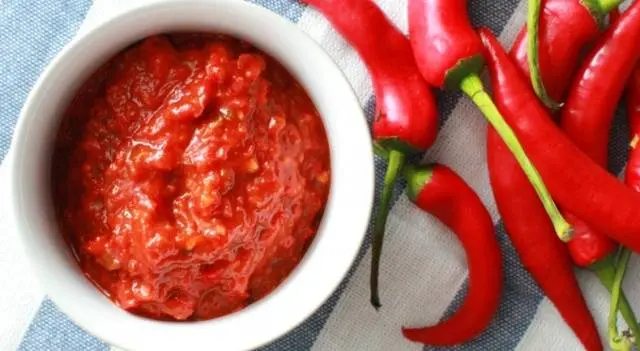
Historical information
Traditionally, it was on the territory of Abkhazia that salt was mixed with pepper and other spices to give it a special taste. From the Abkhaz language, the word “adjika” is translated as “salt”. Over time, the recipe has changed many times. Today, every housewife is looking for her favorite set of ingredients to create the most delicious adjika.
According to tradition, tomatoes were not included in the recipe, but over time they began to be gradually introduced into this dish. Do not be surprised when meeting adjika recipes with an abundance of tomatoes. They are used to give juiciness.
As a rule, adjika is boiled and then sealed in jars, but there are recipes when heat treatment is not required. About them and will be discussed today. So, raw adjika is in no way inferior in taste to boiled. Moreover, the aroma of pepper in it is more intense. How to cook raw adjika and keep it in winter, we will talk below, but for now we will discuss a few simple tips.
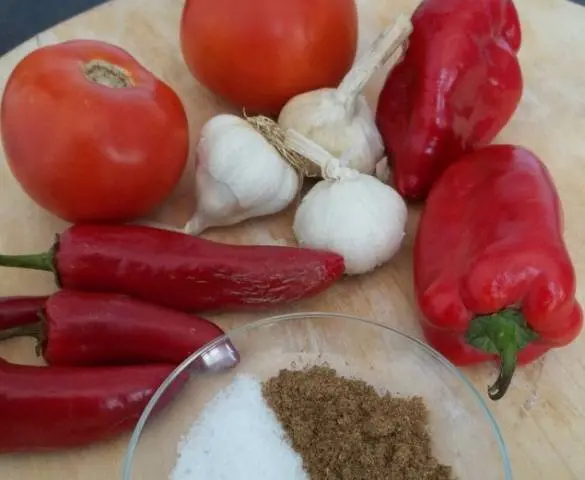
Simple tips for housewives on harvesting vegetables
First of all, I would like to advise all housewives to definitely use one of the recipes below, because such a dish that has not been processed at high temperatures retains not only its unique aroma, but also most of the beneficial properties of pepper, herbs and other ingredients.
When preparing food, wash everything thoroughly, especially fresh herbs. Remember that a snack can turn sour even due to the abundance of raw water that has got into it. After washing, the ingredients are dried on a clean napkin or paper towel.
Adjika is tastier when its mass is heterogeneous. We advise you to grind some of the ingredients in a blender, and pass some through a meat grinder. If the recipe contains tomatoes, choose fleshy ones with a pronounced taste. They will give more juice, and give the snack a unique flavor. If the tomatoes are watery, twist them to drain the excess water. If horseradish root is used as an ingredient, it must be cleaned and ground in the air. This process for some housewives is the most difficult. You can’t bring horseradish close to your face. You also need to be careful when working with hot peppers. To protect yourself, it is better to clean and grind it with gloves.
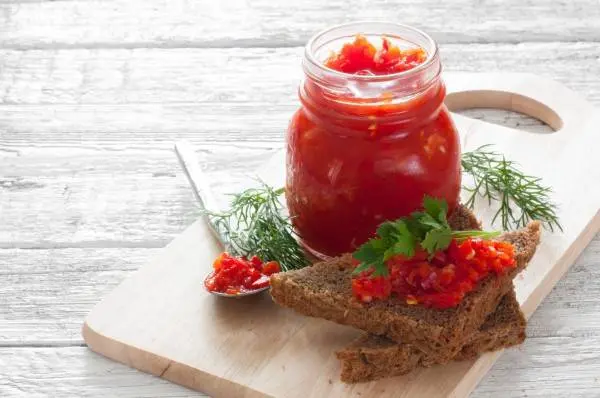
When preparing food, it is best to pre-blanch peppers and tomatoes. They are simply doused with boiling water to quickly remove a thin skin from them. If this is not done, the skin may slightly spoil the taste. In addition, she is hard to chew. Bulgarian pepper is better to use sweet, juicy. Then adjika will be more fragrant.
Absolute sterility is one of the rules when preparing adjika for the winter. And if we are talking about a raw snack, in this case you need to be very careful. The jars are thoroughly washed, best of all with baking soda, poured over with boiling water and dried.
Recipes
Consider some interesting recipes for raw adjika. All of them have been tested for years, and the best of the best have been selected for publication.
Recipe #1. Adjika is a little dill
If you need a unique adjika without vinegar, then this is it. So, for its preparation, the hostess will need:
- sweet bell pepper – 1,5 kg;
- hot pepper – 0,5 kg;
- dill – 200 grams;
- parsley – 100 grams;
- salt – 3 tablespoons;
- garlic – 250 grams.
Raw adjika, the recipe of which is extremely simple, turns out to be quite spicy. It’s perfect for the winter table.
First you need to peel the pepper and scroll it through a meat grinder. Now peel the garlic and add to it. Garlic can be chopped, chopped in a blender or also scrolled through a meat grinder if desired. The last to cut or scroll the greens, after cutting off the stems. Salt is added last and left in a cool place for an hour or two. When the salt dissolves, adjika is mixed, laid out in clean jars and closed. Banks must be sterilized. If someone likes the taste of cilantro, you can add it to the recipe, but no more than one bunch.
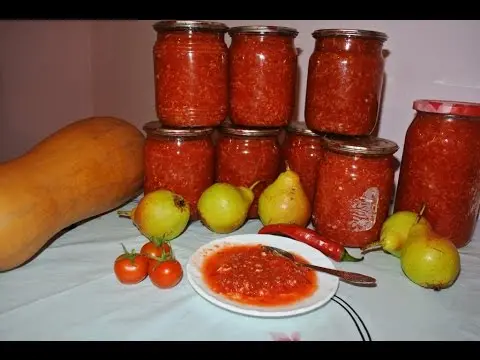
Recipe number 2. Raw adjika with tomato base
Raw adjika from tomato is a juicy tasty dish. Specifically for this recipe you will need:
- tomatoes – 1,5 kg;
- hot pepper – 500 grams;
- garlic – 100 grams;
- salt – 50 grams;
- horseradish root – 100 grams.
Peeled horseradish root is crushed in a meat grinder. It is best to grind it immediately into a bag that is convenient to cork, weigh the horseradish and put it aside.
Now start cooking vegetables. Tomatoes are blanched, peeled, chopped, peeled pepper, minced through a meat grinder, and then garlic are added to them. Now the finished mixture is salted and, at the end, ready-made horseradish is added to it. Everything is thoroughly mixed, poured into jars and stored either in a cold cellar or in a refrigerator. You can adjust the amount of hot pepper to your liking.

Recipe #3. Adjika is hot with horseradish
This recipe is based on quite a lot of horseradish root and garlic. The appetizer tastes very spicy, ideal for a winter dinner. For cooking you will need:
- fleshy tomatoes – 2 kg;
- red sweet pepper – 2,5 kg;
- horseradish root – 400 grams;
- garlic – 200 grams;
- hot pepper – 2 pieces;
- salt – 2 tablespoons;
- sugar – 150 grams;
- table vinegar – 200 grams.
There will be a lot of sauce. First, the horseradish root is cleaned and ground through a meat grinder. Taken aside. Now we need to deal with tomatoes and peppers. Tomatoes are peeled and scrolled through a meat grinder, they also come with peppers. Hot peppers can be ground directly with the seeds to increase the spiciness. Garlic is peeled and crushed as convenient.
Everything is mixed, salt, sugar, horseradish and vinegar are added, mixed again and sent to the refrigerator overnight. Raw adjika for the winter will be ready in the morning. It can be consumed immediately or closed in jars and stored in a cold place at a temperature not exceeding +5 degrees. Such adjika, if properly stored, can stand until the very spring and not lose its extraordinary taste.
Recipe #4. Adjika cheese with walnuts
This recipe is very unique. It is best to use a walnut. It will add a hint of spice. We will need:
- bell pepper – 1 kg;
- meaty tomatoes – 1 kg;
- hot pepper – 500 grams;
- walnut – 200 grams;
- garlic – 200 grams;
- salt – to taste.
All ingredients are cleaned, cut and ground. Salt adjika to taste, store it in the refrigerator. You can use other nuts for cooking, but almonds will add bitterness, and peanuts – sweetness. You can experiment at your discretion.
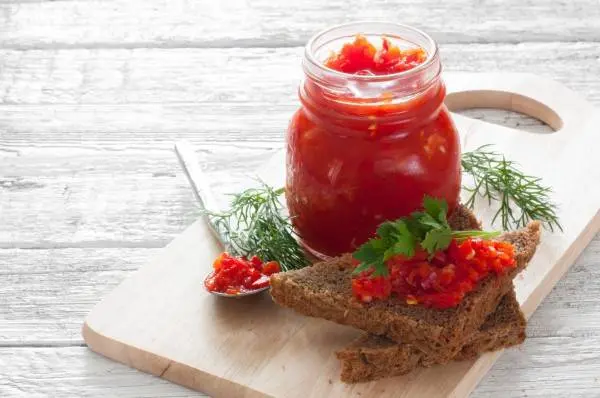
Recipe #5. I’m drinking adjika na zim with ginger
This sauce is more like a mediterranean appetizer. It is very fragrant, has a rich taste, ideal for pasta. Ingredients used:
- fleshy tomatoes – 1,2 kg;
- bulgarian pepper – 1 kg;
- hot pepper – 300 grams;
- ginger root – 80 grams;
- basil – 1 bunch;
- garlic – 200 grams;
- salt – to taste.
Tomatoes and peppers are prepared and chopped as usual. Add chopped garlic (you can cut it with a knife, pass through a meat grinder or garlic press). Lastly, grind the peeled ginger root. It is difficult to grind it, since the internal tendons can wrap around the knife of a meat grinder and blender. We advise you to cut the ginger into small cubes in advance. All ingredients are mixed, the appetizer is salted to taste and sent for storage in jars.
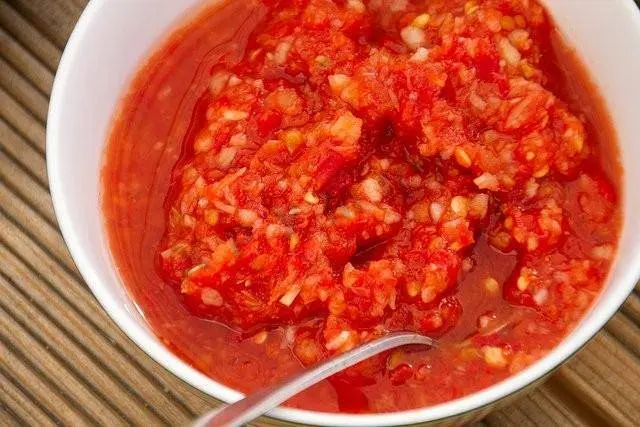
How raw adjika is stored
Cooked adjika should be stored in the refrigerator. However, some housewives complain that the sauce begins to ferment after a month or less. Raw adjika, prepared according to the same recipe by different housewives, can be stored in different ways. Early fermentation is most often due to:
- ingress of raw water;
- low-quality vegetables;
- the ingress of rubbish and dirt.
Of course, raw adjika is tastier and cooks it very quickly, but you should pay special attention to washing vegetables and especially herbs. Mote may be in the axils of the leaves. If there is any doubt that the sauce will not last long, it is better to add a few aspirin tablets to it (1 tablet per liter of sauce is calculated). A good preservative is vinegar and even vodka.
This snack should be spicy. If you close the jars without preservation, then the more sharp components in the composition, the longer it will be stored. Some housewives, when using tomatoes, grind them and boil them, and then add other raw ingredients.
In the manufacture of such a sauce, oxidizable materials are not used, it is mixed only with a wooden spoon. If it is convenient, you can store adjika in plastic bottles. A little vegetable oil is poured on top of the jar or bottle before corking for safety.
Raw adjika is a tasty and incomparable snack. It can please gourmets not only in the summer season, but also be stored all winter, subject to special conditions.









